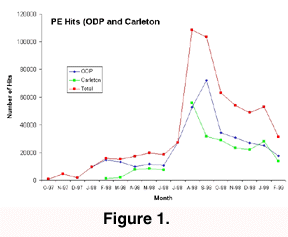The Editors
Palaeontologia Electronica is one year old. It has been an exciting and hectic year for our editorial board as we have explored how to most effectively use the World-Wide Web and Internet as paleontological publication and communications forums. We believe our first year's success can be summed up by the simple fact at no time in the history of paleontology has a publication brought more first- rate paleontological research to the attention of more people (professional, amateur, and lay) for less money. Moreover, Palaeontologia Electronica also serves as a model for how modern communications technology can be used by paleontological organizations in a creative managerial context. The journal is created by an international staff of editors and web site administrators (the vast majority of whom have never met each other face-to-face or spoken over the phone) spread over two continents and one island. The journal's operation is entirely paperless (including all peer-reviews) and accomplished without recourse to staff meetings, conference calls, organizational charts, a separate administrative and/or production tier, or any of the other accoutrements of the contemporary print-publication business. Manuscript turn-around times can be less than a month from initial submission to final publication, all technical manuscripts receive multiple, rigorous, peer-reviews, and there is no backlog of accepted manuscripts waiting to be published.
 One of the most encouraging signs of our success has been the increase in readership through our first year. Access statistics show that following release of Issue 1 Palaeontologia Electronica received approx. 20,000 "hits" from 3,000 addresses originating in over 60 different countries, see Figure 1 (Polly 1998). Although web site hits are not necessarily comparable to journal subscriptions or print runs, the latter are by no means necessarily indicative of readership (sensu stricto). At the time we published the Issue 1 statistics we determned that our circulation compared favorably with those of most major society- sponsored and commercial paleontological journals. However, Palaeontologia Electronica's Issue 2 readership (to date) has been more than triple that of the Issue 1 (at the time of Issue 2's publication). This makes Palaeontologia Electronica one of the most widely accessed paleontological journals in the world! Complete daily hit statistics for the Palaeontologia Electronica home site can be accessed at Site Statistics under About the Journal in the PE site.
One of the most encouraging signs of our success has been the increase in readership through our first year. Access statistics show that following release of Issue 1 Palaeontologia Electronica received approx. 20,000 "hits" from 3,000 addresses originating in over 60 different countries, see Figure 1 (Polly 1998). Although web site hits are not necessarily comparable to journal subscriptions or print runs, the latter are by no means necessarily indicative of readership (sensu stricto). At the time we published the Issue 1 statistics we determned that our circulation compared favorably with those of most major society- sponsored and commercial paleontological journals. However, Palaeontologia Electronica's Issue 2 readership (to date) has been more than triple that of the Issue 1 (at the time of Issue 2's publication). This makes Palaeontologia Electronica one of the most widely accessed paleontological journals in the world! Complete daily hit statistics for the Palaeontologia Electronica home site can be accessed at Site Statistics under About the Journal in the PE site.
Readership at our mirror sites (e.g., Carleton University), not included in the home site statistics, is also high. The very availability of such statistics on an article-by-article basis clearly demonstrates just how different Palaeontologia Electronica is from its print- based fellows. These statistics, plus the fact that Palaeontologia Electronica has attracted the attention of the scientific and popular press, including articles in Newsweek, Science, Nature, and MacCentral (19 August 1998), as well as several newspapers tells us that Palaeontologia Electronica is well on its way to creating a unique niche for itself in the paleontological community by providing challenging new standards in paleontological publishing. The first issue of our second publishing year--our largest issue to date--continues this tradition with new layouts, new features, and, as always, the best in cutting edge paleontology. We've said it before and we'll (probably) say it again.
Welcome to the future of the distant past.

